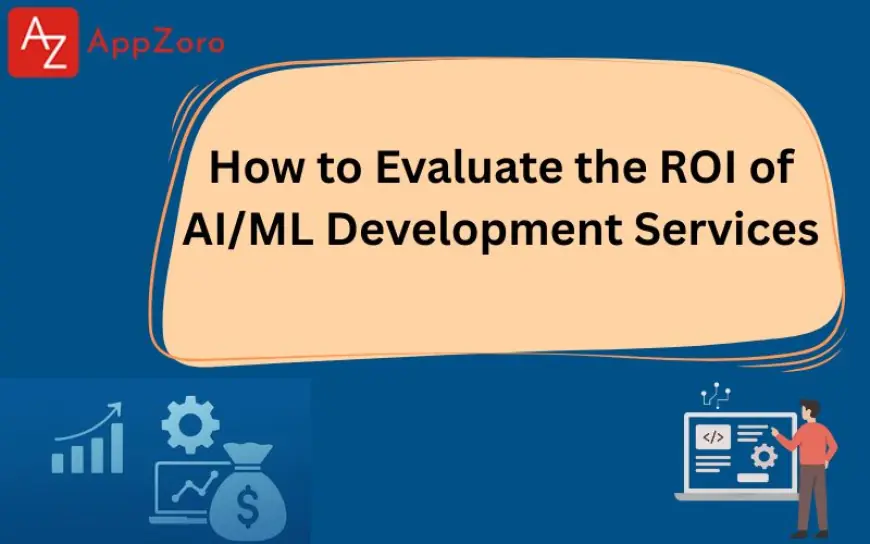How to Evaluate the ROI of AI/ML Development Services
Learn how to measure ROI from AI/ML Development Services in 2025. Discover costs, tools, benefits & best practices to maximize business impact.

In today's digital economy, Artificial Intelligence (AI) and Machine Learning (ML) are no longer just buzzwords — they’re powerful tools for driving business transformation. However, adopting AI/ML without a clear understanding of its return on investment (ROI) can lead to misaligned expectations and wasted resources.
Evaluating the ROI of AI/ML Development Services is essential to ensure your investment delivers measurable value — whether it's in terms of cost savings, operational efficiency, improved customer experience, or increased revenue. In this blog, we'll break down the process of measuring ROI, the challenges involved, and how businesses can maximize outcomes in 2025 and beyond.
What Are AI/ML Development Services?
AI/ML Development Services help businesses design, build, and deploy intelligent systems that learn from data. These services include data analysis, model development, algorithm training, and integration into existing workflows. Companies use them to automate processes, gain insights, and deliver smarter customer experiences through Artificial Intelligence and Machine Learning technologies.
Core Capabilities and Use Cases
AI/ML Development Services refer to a range of professional solutions focused on designing, developing, deploying, and maintaining artificial intelligence and machine learning applications. These services enable businesses to build smart systems that can analyze data, learn from patterns, and make decisions with minimal human intervention.
Typical use cases include:
- Predictive analytics for sales and demand forecasting
- Customer segmentation and personalization in marketing
- Intelligent chatbots and virtual assistants
- Fraud detection and risk analysis in finance
- Image and voice recognition for healthcare and security
These solutions can be fully customized to match specific business goals or delivered as part of a broader digital transformation strategy.
Growth of AI/ML in 2025
As of 2025, the demand for AI and Machine Learning solutions continues to surge. Businesses across every sector — from retail and real estate to healthcare and logistics — are investing in custom AI/ML development to stay competitive. According to recent industry reports, global spending on AI/ML technologies is projected to reach hundreds of billions, as organizations seek smarter, data-driven operations and innovation.
Why ROI Matters in AI/ML Projects
Understanding the return on investment (ROI) for AI/ML projects is crucial because it ensures that the resources spent on technology translate into tangible business benefits. Without measuring ROI, companies risk investing in solutions that don’t align with their strategic objectives or fail to deliver value.
Aligning Tech With Business Goals
AI and machine learning technologies should support your broader business goals—whether it’s increasing revenue, reducing costs, improving customer satisfaction, or enhancing operational efficiency. Aligning AI/ML initiatives with these goals helps prioritize projects that drive meaningful results and justify investment.
ROI as a Success Benchmark
ROI serves as an essential benchmark to evaluate the success of AI/ML projects. It provides a quantifiable way to assess if the project outcomes outweigh the costs, helping stakeholders make informed decisions about future investments and scale initiatives that prove profitable.
Key Costs of AI/ML Implementation
Understanding the costs involved in AI/ML implementation is essential to accurately evaluate ROI. These costs can be divided into development, infrastructure, and ongoing expenses.
Development and Infrastructure
Development costs encompass designing and building custom AI and ML models tailored to your business needs. This process involves data collection, data cleaning, algorithm selection, coding, and rigorous testing to ensure accuracy and performance. Additionally, infrastructure costs include cloud services or on-premise servers required to handle large datasets and support complex computations. Cloud platforms like AWS, Azure, or Google Cloud often charge based on usage, which can fluctuate depending on model complexity and volume of data processed.
Ongoing and Hidden Costs
AI/ML systems require continuous maintenance to stay effective. This includes updating models with new data, monitoring performance to prevent degradation, and refining algorithms as business needs evolve. Hidden costs may also arise from training staff to work with AI tools and adapting existing workflows. Integration with legacy systems can lead to unexpected expenses, especially when bridging older technologies with advanced AI solutions. Accounting for these ongoing and hidden costs ensures a realistic estimate of total investment.
Challenges in Measuring AI/ML ROI
Measuring ROI for AI/ML projects can be difficult due to several challenges. Often, businesses struggle to define clear, measurable goals that capture both short-term and long-term benefits. Additionally, AI/ML solutions may have intangible impacts like improved customer experience or operational agility, which are hard to quantify. These factors make it tricky to evaluate true ROI accurately.
Vague Metrics and Expectations
A common challenge is setting vague or unrealistic metrics before starting AI/ML projects. Without well-defined KPIs, it becomes difficult to track success or failure. Businesses may expect immediate financial returns when many AI initiatives require time to mature. Misaligned expectations between stakeholders can lead to disappointment, making it essential to clarify goals and success criteria upfront.
Data and Model Uncertainty
AI/ML models rely heavily on data quality, which is often inconsistent or incomplete. Poor data can lead to inaccurate predictions and unreliable results, affecting ROI negatively. Moreover, models may perform well in testing but fail to generalize in real-world scenarios. This uncertainty complicates ROI measurement, as outcomes can be unpredictable and fluctuate over time.
How to Measure AI/ML ROI Effectively
Measuring the ROI of AI/ML projects requires a strategic approach that balances both quantitative and qualitative factors. Establishing clear goals and metrics upfront helps in tracking progress and justifying investment.
Set Clear KPIs and Goals
Begin by defining specific, measurable Key Performance Indicators (KPIs) aligned with your business objectives. These may include increased revenue, cost reduction, improved customer retention, or faster decision-making. Clear KPIs provide a concrete way to evaluate the success of AI/ML initiatives and ensure all stakeholders share the same expectations.
Use Both Qualitative and Quantitative Data
While quantitative metrics like ROI percentage and cost savings are essential, qualitative data such as customer satisfaction, employee productivity, and process improvements also add significant value. Combining these data types offers a holistic view of the AI/ML project's impact, helping to capture benefits that numbers alone might miss.
Tools to Analyze AI/ML ROI
Analyzing the ROI of AI/ML projects is made easier with the right tools and platforms. These tools help track performance, visualize data, and quantify the financial and operational benefits of AI solutions. Utilizing specialized dashboards and calculators enables businesses to make data-driven decisions and continuously monitor the value generated by their AI/ML investments.
ROI Calculators and Dashboards
ROI calculators are designed to estimate potential returns based on inputs like project cost, expected savings, and revenue growth. Dashboards provide real-time insights by aggregating key performance indicators, enabling stakeholders to track AI/ML progress visually. These tools improve transparency and help in making timely adjustments to optimize ROI.
Popular Tools and Techniques
Popular tools for analyzing AI/ML ROI include platforms like Power BI, Tableau, and MLflow, which offer data visualization and model tracking capabilities. Techniques such as cost-benefit analysis, total cost of ownership (TCO) assessments, and predictive analytics are often used to evaluate financial impacts and forecast long-term benefits.
Business Impact of AI/ML in 2025
In 2025, AI/ML Development Services continue to revolutionize industries by enabling smarter decisions, increased automation, and enhanced customer experiences. Businesses leveraging AI/ML gain a significant competitive advantage through improved efficiency and innovation. Measuring the business impact today requires understanding both immediate gains and the foundation these technologies build for future growth.
Real-World ROI Case Studies
Many companies have reported impressive ROI from AI/ML projects. For example, retailers using predictive analytics have seen sales increase by 15%, while financial firms employing fraud detection models have reduced losses by millions. These case studies highlight how tailored AI solutions translate into measurable business outcomes, validating investment decisions.
Long-Term Strategic Value
Beyond short-term returns, AI/ML provides long-term strategic value by fostering innovation and agility. AI-driven insights enable businesses to adapt to market changes quickly and develop new products or services. Investing in AI/ML today lays the groundwork for sustainable growth and continued competitive leadership in the years ahead.
Best Practices to Improve ROI
Maximizing the ROI of AI/ML Development Services requires strategic planning and execution. Businesses should focus on selecting the right projects, aligning them with clear goals, and continuously monitoring performance. Implementing best practices such as choosing experienced partners and adopting iterative development helps ensure that AI/ML initiatives deliver measurable and lasting value.
Choose the Right Development Partner
Selecting an experienced AI/ML development partner is critical to success. The right partner brings domain expertise, proven methodologies, and access to cutting-edge tools that accelerate project delivery. They also help avoid common pitfalls like over-engineering or scope creep, ensuring your investment targets impactful solutions tailored to your business needs.
Start Small, Then Scale
Starting with a pilot or minimum viable product (MVP) allows businesses to test AI/ML solutions on a smaller scale, gather feedback, and measure initial ROI. This approach reduces risk and provides valuable insights to refine models before scaling across departments or operations. Gradual scaling ensures resources are efficiently utilized while maximizing business impact.
Conclusion
Summarize the Importance of ROI
Evaluating the ROI of AI/ML Development Services is vital for ensuring your investment drives real business value. Without proper measurement, companies risk overspending on technologies that don’t align with strategic goals. A clear understanding of costs and benefits helps in making informed decisions, optimizing resource allocation, and demonstrating the impact of AI/ML initiatives to stakeholders.
Highlight Strategic Benefits
Beyond immediate financial gains, AI/ML solutions offer long-term strategic benefits such as improved agility, innovation, and competitive advantage. These technologies enable businesses to respond quickly to market changes, create new revenue streams, and enhance customer experiences. Investing in AI/ML is not just about cost savings but building a future-ready organization.
Partner with AppZoro for High-Impact AI/ML Development
For businesses seeking to maximize ROI and drive transformative growth, partnering with an experienced AI/ML development company is essential. AppZoro offers tailored solutions combining technical expertise and industry knowledge to deliver scalable, efficient, and impactful AI/ML projects. Connect with AppZoro to unlock the full potential of AI and machine learning for your business success.
What's Your Reaction?
 Like
0
Like
0
 Dislike
0
Dislike
0
 Love
0
Love
0
 Funny
0
Funny
0
 Angry
0
Angry
0
 Sad
0
Sad
0
 Wow
0
Wow
0


















































